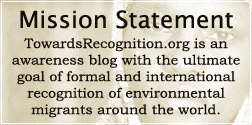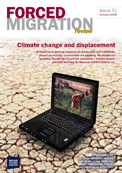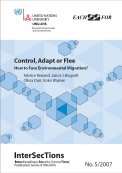The German Marshall Fund of the United States (GMF) has released eight background papers that investigate climate-induced migration. These background papers are a product of GMF’s Transatlantic Study Team on Climate-induced Migration (led by Dr. Susan E. Martin, Georgetown University, and Dr. Koko Warner, UN University). The Study Team consists of scholars, policymakers, and practitioners from the migration and environmental communities. You can find links to the papers below.
Developing Adequate Humanitarian Responses by Sarah Collinson
Summary: Diverse and dynamic patterns of internal and cross-border mobility, migration and displacement are the norm in most countries affected by chronic or recurrent humanitarian crises, which often makes it difficult to distinguish between forced and voluntary migrants because different people adopt highly varied strategies to cope or survive, or to respond to new opportunities. The most negative human impacts of climate change will be reflected in sudden and large-scale forced migration.
Many so-called “fragile states” already fail to provide adequate social protection to poor and vulnerable populations, so any climate-related deterioration in human security has the potential to generate extreme welfare needs that are far beyond the capacities or willingness of these states to address. The sheer scale and complexities of displacement will continue to stretch and challenge the normative, institutional and operational frameworks and capacities of the international humanitarian system and national humanitarian actors. Greater priority needs to be given to flexible humanitarian funding and programming suited to addressing chronic as well as acute humanitarian needs and vulnerability in countries where formal climate change adaptation policies are unlikely to be developed. Superficial climate change adaptation and disaster risk reduction efforts in countries affected by complex and interacting processes including population growth, economic stagnation, conflict, urbanization and environmental stress, are unlikely to influence the deeper dynamics of vulnerability associated with distress migration.
Migration, the Environment and Climate Change: Assessing the Evidence by Frank Laczko
Summary: Four main research challenges are posed by the intersection of climate change, broader environmental hazards and migration: How has the relationship between migration and
the environment been conceptualized? To what extent has it been possible to measure the scale of environmental migration? What evidence is available regarding the impact of environmental migration? What research has been conducted on policy responses? Several factors make it difficult to predict the likely scale of environmental migration or its impacts. First, it is difficult to disaggregate the role of climate change from other economic, political and social factors driving migration. Second, migration data are lacking in developing countries that are likely to be most vulnerable to climate change. Third, the lack of data is largely due to the absence of an adequate definition to cover migrants affected by environmental factors under international law. Fourth, climate modeling techniques have not yet begun to account adequately for the impact of individual choice, the potential for international action and the variability of future emissions and meteorological scenarios. In advancing the future research agenda, it is essential from the outset not to focus solely on the potentially negative consequences of migration. Migration can contribute to adaptation to climate change,
serving as an important strategy to reduce vulnerability to climate change, increase resilience and enable households to accumulate assets. We need much more evidence to demonstrate these impacts and to inform policy.
Climate Change and Migration: Key Issues for Legal Protection of Migrants and Displaced Persons by Michelle Leighton
Summary: There are a number of scenarios in which people could be displaced or forced to migrate due to climate change and extreme weather events. The movement of people in response to these climate-induced events implicates human rights and humanitarian law. Moreover, the potential indirect impacts from the implementation of disaster response strategies or climate adaptation programs can also raise human rights concerns, particularly if the government undertakes to resettle large numbers of people. Of growing concern are serious gaps in the protection schemes provided by existing law, including the extent to which persons adversely affected by climate change can cross international borders in search of jobs or otherwise engage in labor migration as a means of survival.
This paper discusses various ambiguities and gaps in human rights and humanitarian law which leave many climate change victims who are forced to migrate unprotected and vulnerable to abuse. It presents several policy approaches suggested by humanitarian experts to ensure the adequate protection of climate change migrants. The paper concludes that these gaps will need to be addressed either through the further clarification of humanitarian and human rights principles, or through new international standards related to host countries and countries of origin.
Climate Change and International Migration by Susan F. Martin
Summary: Policymakers in potential destination countries for international migrants have been slow to identify possible responses to manage environmentally induced migration that take these complex interconnections into account. Humanitarian admissions are generally limited to refugees and asylum seekers. Most environmental migrants, forced to flee because of loss of livelihood or habitat and not because of persecutory policies, will be unlikely to meet the legal definition of a refugee. In the absence of legal opportunities to immigrate, at least some portion of those who lose livelihoods as a result of climate change and other environmental hazards will likely become irregular migrants. The challenge in these cases is determining whether these individuals should be given consideration over others who migrate in search of better opportunities. Temporary protection policies that permit individuals whose countries have experienced natural disasters or other severe upheavals to remain at least temporarily without fear of deportation may help a limited number of those forced to flee their homes because of climate change, but these will not address the need for permanent resettlement, particularly for the citizens of island nations that may be affected by rising sea levels. Given concerns in many potential countries of destination about the social, cultural, economic and other impacts of large-scale migration, the policy development process will need to balance domestic interests with the clearly humanitarian implications of climate change induced displacement.
Climate Change, Agricultural Development, and Migration by Philip Martin
Summary: This paper reviews the likely effects of climate change on agricultural development and the resulting implications for internal and international migration. The agricultural sector employed about 1.4 billion of the world’s 3.4 billion workers in 2008. Even without climate change, coming years are likely to witness continuing large-scale migration out of the agricultural sector, particularly in developing countries where farm incomes are significantly lower than non-farm incomes. Climate change, specifically global warming, is likely to accelerate this pace of migration. Several economic models project that global warming will have more effects on the distribution of farm production than global farm output, with new areas becoming viable for farming as a result of higher temperatures. However, far more people are likely to be displaced by global warming than those likely to find jobs in these new farming areas. Existing policy addressing the challenges already faced by agricultural workers as they seek alternative economic opportunities is limited. The likely impact of climate change on the agricultural sector, more displacement, underscores the urgent need for policymakers and the international community to commit greater attention and resources towards developing a package of innovative policies to provide workers with alternative opportunities within the agricultural sector or to ease their out-migration from the sector.
Climate Change, Migration, and Adaption by Susan F. Martin
Summary: In the Copenhagen Accords, adopted in December 2009, the international community agreed on the need for enhanced action and international cooperation on adaptation strategies to reduce vulnerability and build resilience in developing countries to meet the challenges of climate change. This paper argues that attention needs to be given to both sides of the environment and migration nexus in adaptation strategies:
(1) Identifying adaptation strategies that allow people to remain where they currently live and work; and
(2) Identifying resettlement strategies that protect people’s lives and livelihoods when they are unable to remain. Since internal migration is the most likely outcome for those affected by climate change and other environmental hazards, highest priority should be given to policies and programs aimed at managing these issues within the most affected countries. Nevertheless, some international migration may well be needed, particularly for the citizens of island nations, necessitating identification of appropriate admissions policies in potential destination countries.
Climate Change, Migration, and Conflict: Receiving Communities under Pressure by Andrea Warnecke, Dennis Tanzler, and Ruth Vollmer
Summary: This paper analyzes the likely intersections between climate change, migration and conflict. The paper identifies some of the most relevant factors that might turn environmentally induced migration into a source of conflict and hold major implications for receiving areas. Scientific literature is still inconclusive about the conflict potential of environmentally induced in-migration and the mechanisms potentially linking it to conflict onset. In general, such mechanisms tend to apply more often in cases of conflict induced as opposed to environmentally induced migration. In a possible chain of events leading from environmentally induced migration to conflict in a receiving area, a host of other factors comes into play, including the causes and type of migration and responses to and perceptions of migration. The impacts of current and future climate trends are likely to increase the pressures that trigger environmentally induced distress migration and migration as a means of adaptation to environmental change. At the same time, climatic and non-climatic factors further strain governance capacities and weaken the stability and the natural resource base of receiving communities, thus making it harder for them to respond to migration appropriately.
Consequently, governments and donors need to invest in (a) extending the knowledge base, for instance by conducting long-term case studies, and (b) supporting mechanisms for receiving communities in devising migration governance strategies based on this knowledge.
Assessing Institutional and Governance Needs Related to Environmental Change and Human Migration by Koko Warner
Summary: Often, the media and policymakers approach the issue of climate change, migration and displacement by asking questions related to “how many” migrants will come. An equally important but less considered question is how national institutions will adapt to accommodate climate change and human mobility. This paper suggests that the capacity of states to adjust to these changes effectively is contingent upon the particular cultural, social, economic and political contexts in which they function and the structural constraints of government machinery. Rather than proposing prêt-a-porter solutions for nation-states, it is important to help states better understand the institutional implications of climate change and human mobility and to aid them in designing custom policies. This paper illustrates these issues with reference to climate change-induced migration in Bangladesh, Mexico and Senegal.




Thank you so much for this!
Simply great, the study included the subject m,atters. I would be happy to share my some of the views on the issue since I also working ob climate induced migrants in Bangladesh. I am an environmental lawyer.